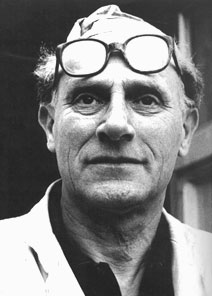 |
|
b i o g r a p h y
1906 Born in Milan in Rovello Street. Historical Centre then a popular quarter that nowadays it's in the heart of the business centre. His home is next to the "Piccolo Teatro". When he was five his father died. He remembers his mother as being "gentle, intelligent, courageous" she used to tell him that he always wanted to be a sculptor. In respect of his fathers will Signori has had a certain psychological influence on his choices. His childhood was spent in a cheerful atmosphere. His grandfather on his mother's side one of the founder's of the Italian Social Party, in his constant referring point of education. Besides politics the family talked about music, literature and representational Art (figurative arts). When Signori was nine he read Dostoievski, he was touched, astonished by what he told and the way it was written. |
 |
| 1920
At fourteen Signori enters the Academy of Fine Art of Brera for a short period. With his
brother Bruno, they join the left wing youth "Arditi del popolo" "The
courageous people" and participates the attacks against the fascists. 1924 He was not seventeen
that he had to seek refuge in France to escape the fascists. His journey assumes epic
remembers "at Domodossola as soon as the train moved on which I was travelling to the
border, there was a cry "Down with the fascists!" the border officials started
to run after the train, threating. But it was too late. We were all singing "Bandiera
Rossa"". 1926 A serious pleurisy
obliged Signori to go to Switzerland for a period of convalescence. On his return the
Academie des Beaux Arts in Paris ad Jean Baucher's student. 1927 Signori dedicates himself above all on painting, exploring many ways. Changes Academy, studying at Ranson with Bissière, in the painting course with Maillol and Melfrey in sculpter up to 1935. 1935 Signori attends the
Academy of André Lothe, he is involved with Artistic Parisian circles of that time. 1939 The day before the declaretion of the second World War, while the Parisian artists had fallen apart because of the political events, Signori took refuge at Saint Raphael, in the south of France. During the Nazi occupation he is saved from deportation thanks to the medical certificate declaring of his serious lung disease. |
|
| 1943 But Signori, returns to Paris (instead) where he
actively takes part with the Resistance movement. 1944 Thanks to a stratagem
Signori succeeds in fleeing from deportation and joins the "maquis' in Central
France. Later he takes part to the battle of Paris and liberation of the city form the
Germans. 1946 Signori founds together
with the painter Zingaro and reporter Lemmi "Francia - Italia" (France - Italy)
Commiftee that carried out an intensive activity of getting together the culture between
the two countries. 1949 Signori worked to make
during three years that monument "Rosselli brothers"whis the marble of Carrara.
his work was admitted the first monument abstract in Europe 1952 Between 1947 and 1952
Signori returns to Carrara several times but he hasn't got the economical means to settle
there. 1953 The invitations to
international artistic shows where numerous. 1956 That year Signori
decides to stop teaching and goes back to Paris, where he finally thinks to be able to
live on his sculptures. 1957 A personal show at the "Gallerie Rive Droite', with the presentation of the Academic of France Marcel Arland. 1958 The Biennial of Venice
assigned him a personal Gallery, where he exhibits 15 works. |
|
1963 Signori is invited to participate and represent Italy in the first International Symposium in Japan. There he meets Fumie Kakinuma, photographer, later becomes his wife. 1966 A great anthology exhibition of the last twenty year of sculpture in marble in the Gallery Charpentier in Paris, one of the most prestigious places to exhibit of the epoch.Signori is one of the participant. 1970 La Roche, one of the most important European pharmaceutical producers, commissioned a big bas-relief for the head office in Paris of the firm, at l'lle de Ia Jatte. Its about a work of 20 Metre lenght by 3 height, to do it he needed 100 Tons of Carrara Marble. 1974 Signori has a very serious heartattack, that makes it impossibile for him to go on with sculpture activity. The artistic lives in Marina di Carrara with his wife Fumie, while in all the world they continue the exhibitions of his works. 1980 A great anthology extabition sculpture in marble in the international Marmi Macchina in Garrara and in city of Milano. 1987 Signori is asked to do a sketch for the monument of Gaetano Bresci an regicide anarchist, after a long national polemic on the opportunity or not to do the work. Signori accepts, and makes the proof on condition that the comity ProBresci, guarantees him, communist ate least of 40 years, an anarchist funeral. The sketch is delivered but the monument is followed by long legal adn ever ending trails, it has not been made up to today. 1988 Signori passed away on the
19th September in Carrara. |
|
home | symposiums | personal exhibitions | group exhibitions | works |
|